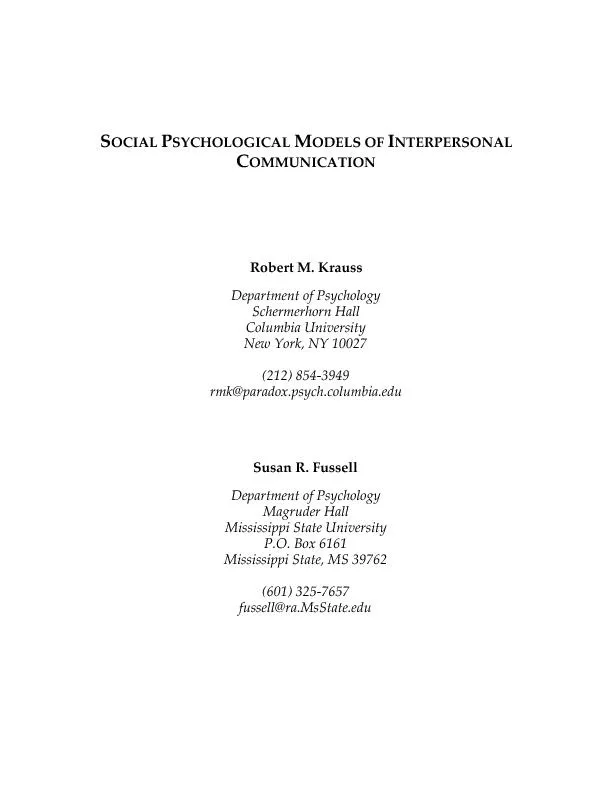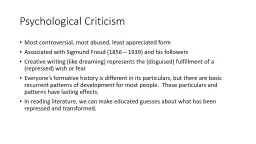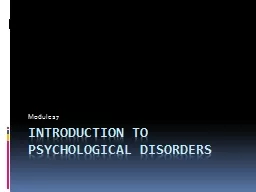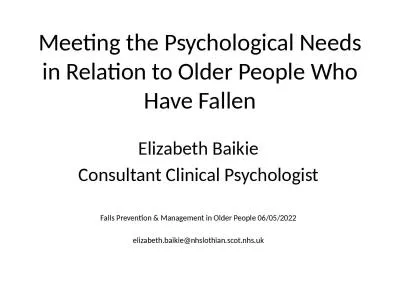PDF-SOCIAL PSYCHOLOGICAL MODELS OF INTERPERSONALCOMMUNICATIONRobert M. Kra
Author : kittie-lecroy | Published Date : 2016-04-30
Models of Interpersonal Communicationpage 2Running Head MODELS OF COMMUNICATIONTo appear in ET Higgins A Kruglanski Eds Social PsychologyHandbook of Basic Principles
Presentation Embed Code
Download Presentation
Download Presentation The PPT/PDF document "SOCIAL PSYCHOLOGICAL MODELS OF INTERPERS..." is the property of its rightful owner. Permission is granted to download and print the materials on this website for personal, non-commercial use only, and to display it on your personal computer provided you do not modify the materials and that you retain all copyright notices contained in the materials. By downloading content from our website, you accept the terms of this agreement.
SOCIAL PSYCHOLOGICAL MODELS OF INTERPERSONALCOMMUNICATIONRobert M. Kra: Transcript
Models of Interpersonal Communicationpage 2Running Head MODELS OF COMMUNICATIONTo appear in ET Higgins A Kruglanski Eds Social PsychologyHandbook of Basic Principles New York Guilfor. Definition. Patterns of behaviour and thought that are atypical, viewed as undesirable, maladaptive and that usually . causes . the persons who experience them considerable distress.. Psychological disorders involve biological, psychological, social and cultural factors.. Building Your MYTHBUSTING Toolkit. Building Your . Mythbusting. Tool Kit. WE MUST:. #1: Become aware of the sources of error . #2: Learn to compensate for them. Building our Defenses to . P. sychomythology. A . case Study of Turkish Higher Education. . EDULEARN 2014. July 2014. . Gamze Sart. Istanbul University . Faculty of Education . &. Technology Transfer Office. INTRODUCTION. In the era of digital transformation, the use of information and communication technologies (ICT) has become as a must in order to achieve more people with affordable prices. . Patrick Rosenkranz, Amy Fielden, Efstathia Tzemou. Outline. The need for a new approach to teaching PSY 2011 . Our approach. Evaluation of the new PSY 2011. Psychology Research Training. In the UK this usually: . Surrendering the. battle . of the. divided self. (44 . slides). creatively . compiled . by dr. michael farnworth . Have you ever felt as if you were your own worst enemy. ?. . That you sabotage the very things you say you want or that you push away the very people you say you want to love the most? . Assist. Prof. Dr. Ozan Örmeci. Girne American University. ISIS TERRORISM FROM A POLITICAL PSYCHOLOGICAL PERSPECTIVE. 1. DEFINITION OF TERRORISM. «A symbolic act designed to influence the political behaviour by extranormal means, entailing the use or threat of violence» . Jack A. Haeger, Michael E. Levin, Ph.D., & Benjamin Pierce. Utah State University. Psychological . F. lexibility. Acceptance. Defusion. Present moment awareness. Perspective taking sense of self. Patrick Rosenkranz, Amy Fielden, Efstathia Tzemou. Outline. The need for a new approach to teaching PSY 2011 . Our approach. Evaluation of the new PSY 2011. Psychology Research Training. In the UK this usually: . Most controversial, most abused, least appreciated form. Associated with Sigmund Freud (1856 – 1939) and his followers. Creative writing (like dreaming) represents the (disguised) fulfillment of a (repressed) wish or fear. Cristina Banks, PhD & Isabelle Thibau, MPH. Interdisciplinary Center for Healthy Workplaces. University of California, Berkeley. Overview. Interdisciplinary Center for Healthy Workplaces. HealthyWorkplaces Model. - Battista . Mantuanus. Psychological Disorder. Psychological . disorder. – a psychological condition characterized by behaviors and/or thinking patterns that are UMAD. Unjustifiable. - irrational, doesn’t make sense to most people. Module 27. Standards. *SSPVB3: The student will identify abnormal behavior and treatment. . a. Identify criteria that distinguish normal from disordered behavior; include the criteria of distress, deviance, and dysfunction. . 1 : a highly endangered Northern Tai language with a Kra substratum Andrew Hsiu (andhsiu@gmail.com) https://sites.google.com/site/msealangs/ Center for Research in Computational Linguistics (CRCL), B Elizabeth Baikie. Consultant Clinical Psychologist. Falls Prevention & Management in Older People 06/05/2022. elizabeth.baikie@nhslothian.scot.nhs.uk. Overview. Psychological . Needs/Values . & Life .
Download Document
Here is the link to download the presentation.
"SOCIAL PSYCHOLOGICAL MODELS OF INTERPERSONALCOMMUNICATIONRobert M. Kra"The content belongs to its owner. You may download and print it for personal use, without modification, and keep all copyright notices. By downloading, you agree to these terms.
Related Documents














